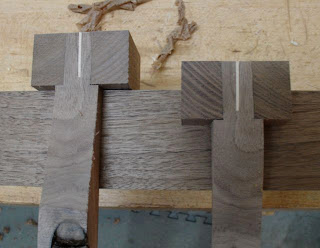It's been some time since I've posted to my blog but I have a good excuse -- knee surgery on the 29th. of April. I'm much improved but didn't go up the stairs to my bedroom or the gilding area so the frame is all gilded and ready for toning. Since that requires longer periods of time I'm putting that project on hold until my knee tells me it can stand on its' own for a number of hours.
In the meantime, I've started a new project and am currently working on some prototypes for it. When we went to Pasadena I noticed a lumber yard called Arroyo Hardwoods. Decided to check it out and ended up with a nice piece of 8/4 Zebrawood just begging to be re-sawn and book matched! We have the need for some small tables to use as side tables for company or ourselves -- think TV trays. I rarely take the easy way in my designs and this will be no exception. I've seen lots of rectangular or square tables so decided to try a triangular or a truncated rectangle. You knew that would lead to prototypes so here's what's going on. The first thought was to make them stackable but that didn't work out too well so I went for the rectangular theme. They will be made of Walnut with the Zebrawood as an inset. Since I want them to appear quite light I decided to not use an apron but rather mortise the legs into the sides with an overlap type of joint, here's that prototype:
 |
| Traditional Leg with Inlay |
The top was made first out of Poplar. The first leg design included an inlay which I initially thought could be attractive. Now that I see it I disagree, the top is sleek and contemporary while the leg looks somewhat traditional. It just didn't have the flow I was looking for.
 |
| Triangular Shaped Leg |
The intent of the next leg design was to micmic the triangular shape of the top, this too was attached with a lap joint. What I do when I work on designs is to make the mock-up and just place it in the room for a while to see how it would work. The decision is that it wouldn't!, looks too bulky and heavy. I want these tables to have a very light appearance.
Where I am now is to place the legs under the table to maintain a clean edge all the way around the top. One concern I've had was with the stability of using three legs. From the mock-ups I've constructed so far it doesn't seem to be an issue. Since they will be used to place a drink or snack on they won't be knocked around much. Here is the final prototype:
 |
| Final Prototype |
The legs are mortised into the top. The largest mortising chisel I have is 5/8" so I made the legs 1" square to allow for a 3/16" shoulder all around. The mortise is completely through the top and will be secured with glue and a wedge. Things look a little awkward in this photo because there are gaping holes where the initial legs were attached. The cardboard top is a poor substitute for the Zebrawood I plan on using and you really have to stretch your imagination to have the Poplar become Walnut. Next step will be to see how the Walnut works for this design.









